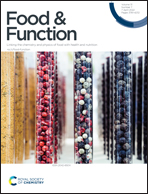Bioaccessibility and intestinal cell uptake of carotenoids and chlorophylls differ in powdered spinach by the ingredient form as measured using in vitro gastrointestinal digestion and anaerobic fecal fermentation models†
Abstract
Insights into food matrix factors impacting bioavailability of bioactive carotenoids and chlorophylls from fruits and vegetable ingredients are essential to understanding their ability to promote health. The stability and bioaccessibility of carotenoids and chlorophylls were assessed from dehydrated, spray-dried, freeze-dried and fresh spinach ingredient forms using in vitro models simulating upper gastrointestinal (GI) digestion and lower GI anaerobic fecal fermentation. Intestinal transport of bioaccessible bioactives from both upper and lower GI compartments was assessed using the Caco-2 human intestinal cell model. Differences in carotenoid and chlorophyll contents were observed between ingredient forms and these influenced bioaccessibility. Lower carotenoid and chlorophyll contents in spray dried spinach resulted in the lowest total bioaccessible content among all spinach treatments (5.8 ± 0.2 μmoles per g DW carotenoid and chlorophyll). The total bioaccessible content was statistically similar between freeze-dried (12.5 ± 0.6 μmoles per g DW), dehydrated (12.5 ± 3.2 μmoles per g DW), and fresh spinach (14.2 ± 1.2 μmoles per g DW). Post anaerobic fermentation, cellular accumulation of carotenoids was higher (17.57–19.52 vs. 5.11–8.56%), while that of chlorophylls was lower (3.05–5.27 vs. 5.25–6.44%), compared to those observed following upper GI digestion. Collectively, these data suggest that spinach forms created by various drying technologies deliver similar levels of bioaccessible spinach bioactives and that the lower GI tract may serve as a site for significant absorption fostered by interactions with gut microbial communities that liberate additional bioactives from the spinach matrix.

- This article is part of the themed collection: Effect of food matrix & processing on the physiological fate of bioactive compounds & metabolites


 Please wait while we load your content...
Please wait while we load your content...
